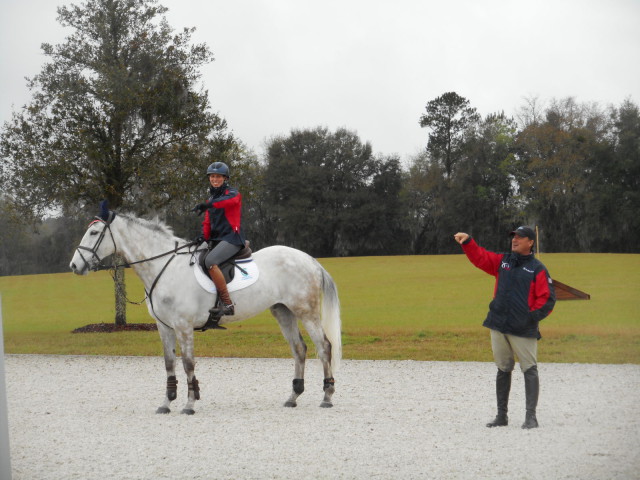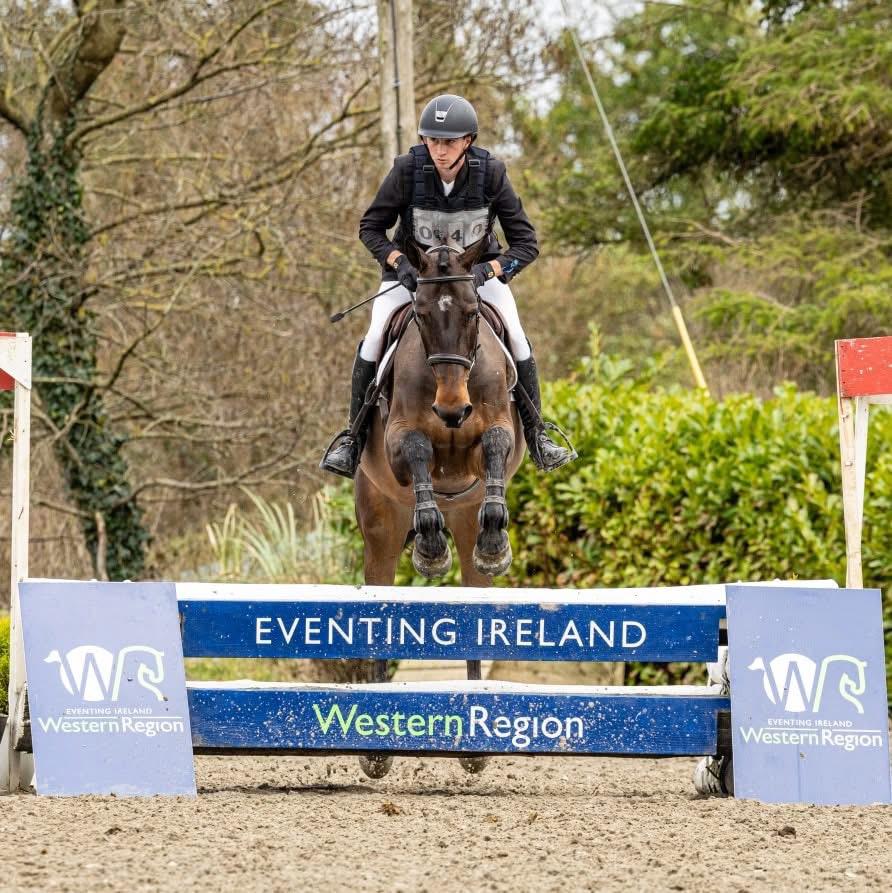 This way? That way? David O'Connor and Liz Halliday-Sharp decide which jumps to tackle. Photo by Rachael Walker.
This way? That way? David O'Connor and Liz Halliday-Sharp decide which jumps to tackle. Photo by Rachael Walker.
This post should probably be subtitled “The two days I spent stalking David O’Connor.” I am a self-admitted auditor-a-holic. I love watching a clinician teach an array of riders for an entire day or weekend. I will jump crew until my arms fall off to be close enough to hear every word.
So when the list went up with the High Performance training session dates, I thought: “Here it is! The excuse I’ve been waiting for to get out of the frozen Wisconsin tundra and fly somewhere warm!” Not to mention, two days of getting to watch our nation’s top riders train with DOC. Hello, Priceline!
I arrived at Meredyth South in Ocala on day one of the training sessions, armed with my chair; my camera; and a backpack full of snacks, notebook, sunglasses, water bottle, extra pens and phone. The only thing I was missing was a sign plastered to my forehead reading “Tourist From the Great White North!” — although that sign probably would have been redundant.
I found David teaching Julie Richards in the dressage ring, where he greeted me warmly (and proceeded to answer the many questions I threw at him throughout the training sessions). And from there we took off, spending two days running between the dressage ring, cross country field, stadium ring and Longwood South’s covered indoor after the rain got to be too much on Tuesday. In the afternoons, Silvio Mazzoni was up in the jumper ring, which was a treat to watch.
There are many take-aways from any clinic: nuggets of wisdom from the instructor that resonate with you; observing the riding styles and effectiveness of any given rider; watching a trainer make changes in a horse and rider; and, at times, seeing things that the trainer tries out that don’t work for a particular pair.
It’s educational to watch the clinician, rider and horse work through exercises that are more routine and see how the instructor handles bigger issues that crop up when a horse or rider is stuck.
This particular clinic was fantastic both in how it was special and different, but also in how it was the same as any other clinic. Many of the exercises, key concepts and phrases David repeated through the lessons weren’t anything different from what most instructors are doing with students day in and day out. Newsflash: It really is all about the outside rein. And even our top riders sometimes struggle to get their bodies to be in the right places at the right times.
But, even though there was nothing too earth-shattering going on — there was. When Silvio asked a rider to put 6, 7 or 8 strides in a given line, they did. Immediately. These riders know how to put a horse where they want it and adjust accordingly.
The riders’ level of attention to detail is part of what makes them as good as they are. Whereas a rider like me will have a lesson that is all about trying to get eight #!$% strides in that combination, it was routine for every rider I watched.
When David asked for a rider to put a horse low, go from collected to medium to collected within a shoulder-in or haunches-in or execute a flying change, it happened. The level of precision and detail displayed by these riders is what we should all be striving for.
There were moments I’ll be taking back to my own students, like when David and Liz Halliday-Shap had a great discussion about placement of a serpentine and, after Liz tried breaking things down into algebra (“That would be geometry, Liz,” says David. “Don’t make me do math at all!” she retorts), David got out his little orange cones and put out “gates” for Liz to ride through so that they were both clear of the place on the sides of the ring where the serpentine would touch.
I live for orange cones. And now none of my students have to feel inadequate, because the horse and rider pair utilizing the cones at that particular moment are aiming for Rolex this spring and riding with the U.S. team’s chef d’equipe.
Both David and Silvio repeatedly asked for riders to soften the horse, then allow the stretch in the neck. Many riders were told to press their hands/elbows slightly forward, to supple and then release, to let the horse stretch into the contact — in both dressage and jumping. Both coaches frequently asked riders to give the horse a pat. Both used exercises to get a rider turning with the outside rein, and both asked for precision as well as relaxation in riding.
My personal horse is a sometimes tricky, hot little mare, and there was something I watched many riders do that made an impression on me. Inevitably, riders would get to “that spot” with their horses — the one where the horse is amped to jump, wound by the environment or whatever it is and starts to have a bit of a meltdown. Or, as my one trainer puts it, “the wheels fall off.”
Every rider I watched took a moment, a time-out of sorts, to release the reins, rub the horse’s neck and basically say, “It’s OK, you’re all right,” before picking the reins back up and restarting.
We all know how frustrating these moments can be, and, as competitive human beings, our instinct is often to “push through it.” But by allowing the horse to take a 5- or 10-second breath, get a little scratch and a rub, and re-set his mind, riders were then able to pick back up and start again with a horse that was in a better head space.
It’s great to belong to a sport where the horses aren’t seen just as machines, and time was taken with each horse over the two-day clinic to make sure the exercises were appropriate and helpful and that the horse came away feeling good about his or her work.
I was greeted warmly by all of the riders, as well as David and Silvio (obvious as it was that I was the Wisconsin tourist acting like a kid in a candy store); kindly chauffeured around in David’s golf cart when we had to travel a long ways; and spent two great afternoons moving jumps for Silvio. My overall impression was that this is a great group of people working together to get the best out of their horses.
And the Florida sunshine didn’t hurt, either. I mean, palm trees around the water complex. Palm trees!
Go Florida. Go Eventing.
- David O’Connor and Julie Richards in the early morning session on Monday. Photo by Rachael Walker.
- 10-meter canter circles, concentrating on the outside turning aids, were used abundantly across all the lessons. Photo by Rachael Walker.
- More work on a 10-meter canter circle. Photo by Rachael Walker.
- David O’Connor coaches Buck Davidson. Photo by Rachael Walker.
- Liz Halliday-Sharp and Fernhill By Night. Photo by Rachael Walker.
- Liz Halliday-Sharp and Fernhill By Night. Photo by Rachael Walker.
- David O’Connor looks on as Marilyn Little navigates a corner.
- David O’Connor’s fabulous dog Bourbon getting some loving. Photo by Rachael Walker.
- Cab driver. Photo by Rachael Walker.
- The man himself hops on to warm up one of Marilyn’s horses. Photo by Rachael Walker.
- Lauren Kieffer jumping in the rain on Tuesday. Photo by Rachael Walker.
- Lynn Symansky on a feisty little mare. Photo by Rachael Walker.
- This way? That way? David O’Connor and Liz Halliday-Sharp decide which jumps to tackle. Photo by Rachael Walker.
- More pointing! Liz Halliday-Sharp and Sinead Halpin discuss hill work. Photo by Rachael Walker.
- Liz Halliday-Sharp gallops around the top cross-country field. Photo by Rachael Walker.
- Buck Davidson joked on Tuesday that he was just prepping for Badminton. Photo by Rachael Walker.
- Ahhhh, Florida! Photo by Rachael Walker.
- David O’Connor whips out his cones as Liz Halliday-Sharp looks on. Photo by Rachael Walker.












































